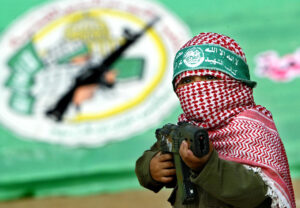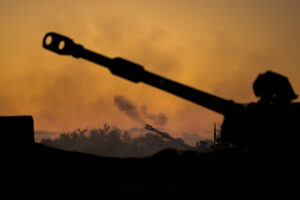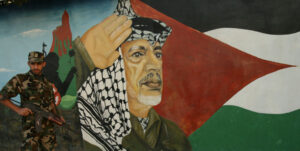As well as an atrocity, the October 7 massacre was a media sensation. With the use of $150 GoPros strapped to its terrorist foot soldiers, Hamas thrust its obscenities into almost every news channel, paper and feed in the world. If you wanted to understand the democratisation of broadcasting through a single event, this was it.
In the Israel-Palestine conflict, the disequilibrium of military power is such that the battlefield outcome is predetermined: Israel cannot lose; Hamas cannot win. Beyond a single surprise attack, Hamas cannot fill screens with mass Israeli dead and force Israel to stop. Instead, it proffers its own dead to the world to make global condemnation force Israel to stop.
At the centre of Hamas’s media operation sits Al-Aqsa (literally “furthest mosque”), the name of Hamas’s TV channel, radio station and social media channels (though the latter have mostly been banned). Funded by Hamas’s general budget — which comes from siphoning off aid that comes into the Strip, foreign countries such as Iran and Qatar, and its own tax collecting — it began broadcasting in Gaza in 2006 after Hamas came to power. By the time the terrorist group launched its October 7 attack, Al-Aqsa’s various channels were broadcasting everything from news and drama to children’s entertainment. From its inception, however, all of the network’s content has been informed by a two-pronged strategy.
The first concerns indoctrination in the service of resistance, and has a particular focus on inculcating antisemitism and anti-Israeli activity into children. An instructive example is Tomorrow’s Pioneers, which features Farfour the Mouse, a costumed character with a high-pitched voice who bounds about squeaking joyously, simulating firing AK-47s and throwing hand grenades. “You and I are laying the foundation for a world led by Islamists,” he tells his young viewers. “We will return the Islamic community to its former greatness, and liberate Jerusalem, God willing, liberate Iraq, God willing, and liberate all the countries of the Muslims invaded by the murderers.” In 2007, Farfour’s story arc sadly ended with him being beaten to death by an Israeli interrogator. It was, the show’s producer said, intended to usher in a new direction for the programme.
Al Aqsa has featured a series of music videos aimed at radicalising children. In one, a four-year-old girl is seen singing to her “mother”, identified as “mother Reem” (an apparent reference to Hamas’s first female suicide bomber Reem Riyashi). Later in the video, the woman blows herself up, killing four Israeli soldiers. After her mother carries out the attack, the little girl holds an explosive and sings to the camera: “I am following Mommy in her steps.”
In 2009, Al-Aqsa published Hamas’s first feature-length film, which celebrated the life and death of an Al-Qassam Brigade militant from the first intifada. The movie encouraged “mosque youth” to act as informants for Hamas-controlled intelligence organisations. Another video segment carried an interview with a son of Umm Nidal, a Gazan whose four sons became suicide bombers. “I ask all Muslim sisters, mothers and daughters and sisters, that the Al Aqsa expects us, the next generation, to fall into line for it, God Willing and Exalted,” he says. “Do not withhold from us the commanders, do not withhold from us the soldiers, and do not withhold from us lovers of martyrdom.” Perhaps unsurprisingly, in 2016, the US State Department named Fathi Hamad, Al-Aqsa TV’s founder and director, a “Specially Designated Terrorist” because the station’s continual airing of “programs designed to recruit children to become Hamas armed fighters and suicide bombers”.
The second prong of Hamas’s media strategy centres on its role as a competent governing force in Gaza, highlighting the various state functions it claims to fulfil. Popular programmes include EayanA alaAldifa (Eyes on the West Bank), which is concerned with the issues of people in West Bank, Ashab al-ard (Landowners), which deals with problems of ordinary Gazans, and Nafidhat Al-khayr (The Goodness Way), which highlights the humanitarian issues and support given by Hamas to families in need.
In recent years, this emphasis has gradually bled over onto its social media channels; a study of Hamas’s X account from 2015 to 2018 found that the group mostly posted about “its internal governance and foreign policy, with the smallest focus on resistance”. And just as on television, all this output is tightly controlled. In 2014, Hamas Interior Ministry offered guidelines to “social media activists” via a video from its official website. “Anyone killed or martyred is to be called a civilian from Gaza or Palestine,” it ordered. “Before we talk about his status in jihad or his military rank, don’t forget to always add ‘innocent civilian’ or ‘innocent citizen’ in your description of those killed in Israeli attacks on Gaza.”
It continued: “Begin [your reports of] news of resistance actions with the phrase ‘In response to the cruel Israeli attack”, and conclude with the phrase ‘This many people have been martyred since Israel launched its aggression against Gaza’. Be sure to always perpetuate the principle of ‘the role of the occupation is attack’, and we in Palestine are fulfilling [the role of] the reaction.”
Yet as with so much in the region, this all changed on October 7. That day, Al-Aqsa broadcast footage of burning cars in Israeli towns alongside a video of a group of young Israeli men with arms tied behind their backs. “This picture is your picture, this night is your night, this flood is your flood, and this blessed action is for all of you,” the anchor declared triumphantly. The programme then cut to a message from the deputy chief of Hamas’s political bureau Saleh al-Arouri, who called for an uprising in the West Bank: “[The IDF] won’t be able to attend to confrontations on other fronts,” he promised.
More broadly, though, October 7 represented the moment Hamas’s emphasis shifted from legacy to social media — and, critically, when the main driver of output switched from Hamas itself to its armed wing, the Al-Qassam Brigades. “Since October 7, the group’s media operations are unsurprisingly dominated by the Al-Qassam Brigades’ media and its spokesman, Abu Obayda,” Aymenn Jawad al-Tamimi, Fellow of the Middle East Forum, tells me. “This reflects the reality of the war in which it is Hamas’s operatives in Gaza who primarily control the narrative and not its political leaders in exile in Qatar and elsewhere. And, it is, after all, the group’s status as a military ‘resistance’ force that matters most to supporters around the world and observers more generally.”
As far as social media campaigns go, it has undoubtedly been a success. In the days following Hamas’s attack, the group’s Telegram channel tripled in followers, from 340,000 to 1.3 million followers. Prior to the massacre, its average post received 25,000-30,000 views, a figure which increased tenfold to more than 300,000. Similarly, Al-Qassam Brigades’ account grew from 205,000 subscribers on 7 October to 619,000 on 12 October. Both accounts remain active, though they are barred in certain regions, such as the EU, UK, US and Israel.
Also noticeable was the style of their content. In late October, I attended an IDF screening of footage from Hamas’s attack. What struck me was the video-game-like nature of the violence; terrorists ran around shooting civilians as if they were in Grand Theft Auto. In the weeks since, the first-person has remained their favoured style, with much of Al-Qassam’s content designed to portray its troops as elite soldiers.
If this all seems crude, its impact cannot be discounted. On 13 October, Hamas released a video on Telegram that purported to show its terrorists soothing a crying baby; another fighter bandages the foot of an Israeli toddler. This type of footage may not have much purchase in the West, but more than 1.4 million watched it on Al-Jazeera’s Facebook page for Egypt. Former advisor to Palestinian Authority, Ghaith al-Omari, said the videos had convinced many in the Arab world that, unlike Isis, Hamas “are humane and respect Islamic laws of War”.
Such widespread dissemination follows a simple but effective structure. Content begins at the primary level: from official Hamas and Al-Qassam Brigades’ channels and accounts. It then travels to unofficial accounts and supporters (though these are also increasingly becoming banned as social media companies crack down). These accounts typically reshare official content but also generate their own material. Examples include the Gaza Now Facebook account (which had 4.9 million followers before being banned) and Instagram’s @eye.on.palestine (which has 9.6 million and can still be accessed in certain countries).
The third level consists of a range of informal pro-Palestinian groups and channels, including those set up by influencers. This is arguably the most effective level of dissemination as it uses ordinary people — seemingly unaffiliated to Hamas – to tell “authentic” stories of suffering. What emerges is often described as the “true” picture or story from Gaza and is coupled with the popular hashtags — #IsraeliCrimes, #AlAqsa, #FreePalestine, #StandWithPalestine — that allow this sort of content to go globally viral.=
If Israel is overwhelmingly dominant on the ground, it is hopefully outmatched by Hamas and its supporters online. #freepalestine is found on 39 times more Facebook posts than #standwithisrael. On Instagram, pro-Palestinian hashtags are found on 26 times more posts than pro-Israel ones.
This is war fought on two planes; and if Israel is doing its best to level Hamas in Gaza, it is losing badly across the world online. The irony, of course, is that nowhere is Hamas clearer about who it is and what it wants than in its output. As an IDF official told me recently: “if Western audiences actually listened to the interviews given by Hamas officials, the Israeli media effort could just shut down. Hamas makes the case for Israel’s war against them better than any Israeli official ever could.”
Disclaimer
Some of the posts we share are controversial and we do not necessarily agree with them in the whole extend. Sometimes we agree with the content or part of it but we do not agree with the narration or language. Nevertheless we find them somehow interesting, valuable and/or informative or we share them, because we strongly believe in freedom of speech, free press and journalism. We strongly encourage you to have a critical approach to all the content, do your own research and analysis to build your own opinion.
We would be glad to have your feedback.
Source: UnHerd Read the original article here: https://unherd.com/




